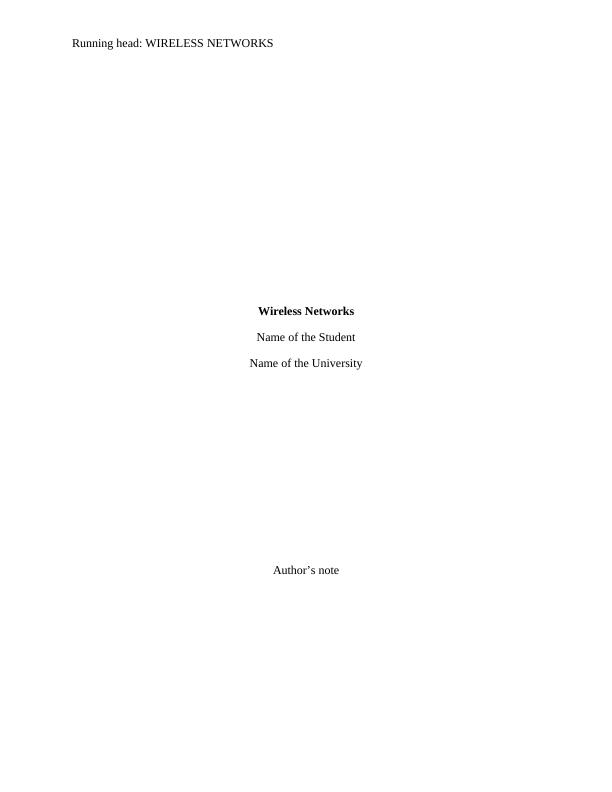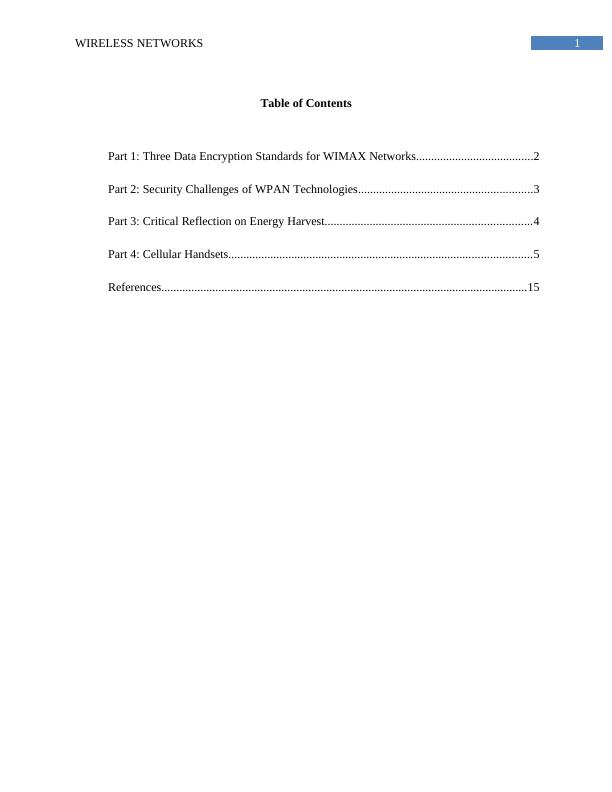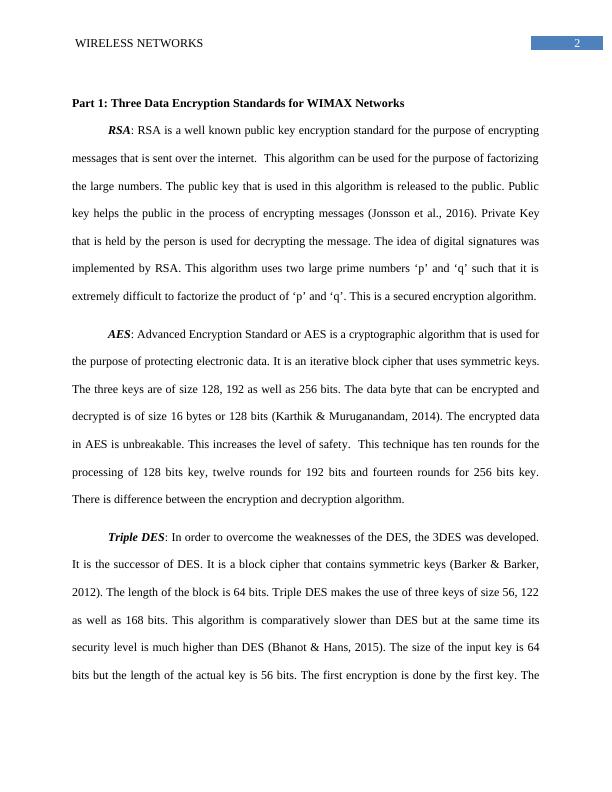Data Encryption Standards for WIMAX
19 Pages1868 Words69 Views
Added on 2020-04-01
Data Encryption Standards for WIMAX
Added on 2020-04-01
ShareRelated Documents
Running head: WIRELESS NETWORKSWireless NetworksName of the StudentName of the UniversityAuthor’s note

1 WIRELESS NETWORKSTable of ContentsPart 1: Three Data Encryption Standards for WIMAX Networks.......................................2Part 2: Security Challenges of WPAN Technologies..........................................................3Part 3: Critical Reflection on Energy Harvest.....................................................................4Part 4: Cellular Handsets.....................................................................................................5References..........................................................................................................................15

2 WIRELESS NETWORKSPart 1: Three Data Encryption Standards for WIMAX NetworksRSA: RSA is a well known public key encryption standard for the purpose of encryptingmessages that is sent over the internet. This algorithm can be used for the purpose of factorizingthe large numbers. The public key that is used in this algorithm is released to the public. Publickey helps the public in the process of encrypting messages (Jonsson et al., 2016). Private Keythat is held by the person is used for decrypting the message. The idea of digital signatures wasimplemented by RSA. This algorithm uses two large prime numbers ‘p’ and ‘q’ such that it isextremely difficult to factorize the product of ‘p’ and ‘q’. This is a secured encryption algorithm.AES: Advanced Encryption Standard or AES is a cryptographic algorithm that is used forthe purpose of protecting electronic data. It is an iterative block cipher that uses symmetric keys.The three keys are of size 128, 192 as well as 256 bits. The data byte that can be encrypted anddecrypted is of size 16 bytes or 128 bits (Karthik & Muruganandam, 2014). The encrypted datain AES is unbreakable. This increases the level of safety. This technique has ten rounds for theprocessing of 128 bits key, twelve rounds for 192 bits and fourteen rounds for 256 bits key.There is difference between the encryption and decryption algorithm.Triple DES: In order to overcome the weaknesses of the DES, the 3DES was developed.It is the successor of DES. It is a block cipher that contains symmetric keys (Barker & Barker,2012). The length of the block is 64 bits. Triple DES makes the use of three keys of size 56, 122as well as 168 bits. This algorithm is comparatively slower than DES but at the same time itssecurity level is much higher than DES (Bhanot & Hans, 2015). The size of the input key is 64bits but the length of the actual key is 56 bits. The first encryption is done by the first key. The

3 WIRELESS NETWORKSdecryption is carried out by the second key followed by the second encryption process that isdone by the third key.Part 2: Security Challenges of WPAN TechnologiesSecurity Challenges in Bluetooth Technology: The Bluetooth technology is used fordeveloping PAN that connects wireless devices. These devices share important files and data thatare vulnerable to certain number of security threats. Malicious codes can enter the device andaffect the system by misusing or removing the personal details of the owner of the device.Bluesnarfing can also take place where the attacker gets unauthorized access to the personal datalike contacts and photographs of another device (Minar & Tarique, 2012). In Bluejacking theattacker masquerades his personality and pairs up with another device in order to misuse thesensitive data of the other device (Padgette, 2017). In the technique of Backdoor hacking adevice that is not yet paired with another device is still capable of accessing its data. Here thevictim is unaware of the attack. The attacker carries out this process in a silent manner.Security Challenges of ZigBee: ZigBee is considered to be a standard that is used forPAN. ZigBee can be used in several devices like remote control, home automation as well as inretail services. There are major security flaws in the wireless networks. The encryption key ofZigBee can be hacked by sniffing attacks (Zillner & Strobl, 2015). In a sniffer attack theattacking device is able to read and capture the messages that are being exchanges as well as geta view of the packets in the network. The nodes present in the network can masquerades itsidentity to attack an encryption key (Wang, Jiang & Zhang, 2014). The attacker can use injectionattack as well as packet replay attack. The attacker has the capability to trick any device to

End of preview
Want to access all the pages? Upload your documents or become a member.
Related Documents
Three Data Encryption Standards for WIMAX Networks Part 1: Wireless Networkslg...
|14
|1565
|42
Security Challenges of WPAN Technologieslg...
|7
|1282
|84
Assignment Wireless Networking (WSNs)lg...
|9
|1464
|252
Security Challenges of Two Examples of WPAN Technologieslg...
|10
|2284
|172
Wireless Communication Standardlg...
|10
|1400
|94
WiMAX Networks Security Reportlg...
|3
|1235
|48
